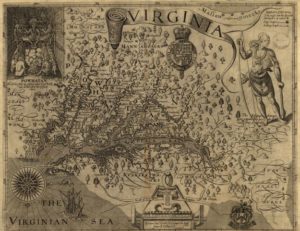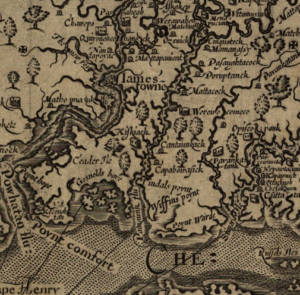When most people think about interactions between Virginia Indians and the English, they often think of the daring Captain John Smith. However, there is much more to Smith’s experience with the Powhatan than the story of his encounter with the “princess” Pocahontas. Opechancanough (oh-pee-KAAN-kuh-noo), the chief of the Pamunkey tribe and the brother of the paramount chief, Powhatan (POH-uh-taan), captured John Smith while the Englishman was exploring the area. Smith was taken to different towns within the Powhatan chiefdom, meeting Pocahontas along the way. During his time in captivity he was able to observe the Powhatan and used the information he gathered to make a map of the area surrounding Jamestown. This map is remarkably detailed and includes Kiskiak, although it is oriented differently from modern maps. Most modern maps have North at the top and South at the bottom, but this one is intended to show the direction that the English sailed when they arrived in Virginia.


This detail shows Kiskiak (spelled “Kiskiack”) and Werowocomoco (WAYR-uh-wah-KOH-muh-koh), the central town of the Powhatan chiefdom where Smith met Pocahontas.
Colonists from Jamestown visited Kiskiak multiple times, but no lasting relationship ever developed between the residents of Kiskiak and the English. Contact between the two groups became progressively more violent during the 1610s. The colonists burned Kiskiak’s houses and looted its food storage during a series of “feed fights,” prompting the native people to leave the town sometime between 1623 and 1627. The Kiskiak moved north into the Middle Peninsula, settling down between the York and Rappahannock Rivers.